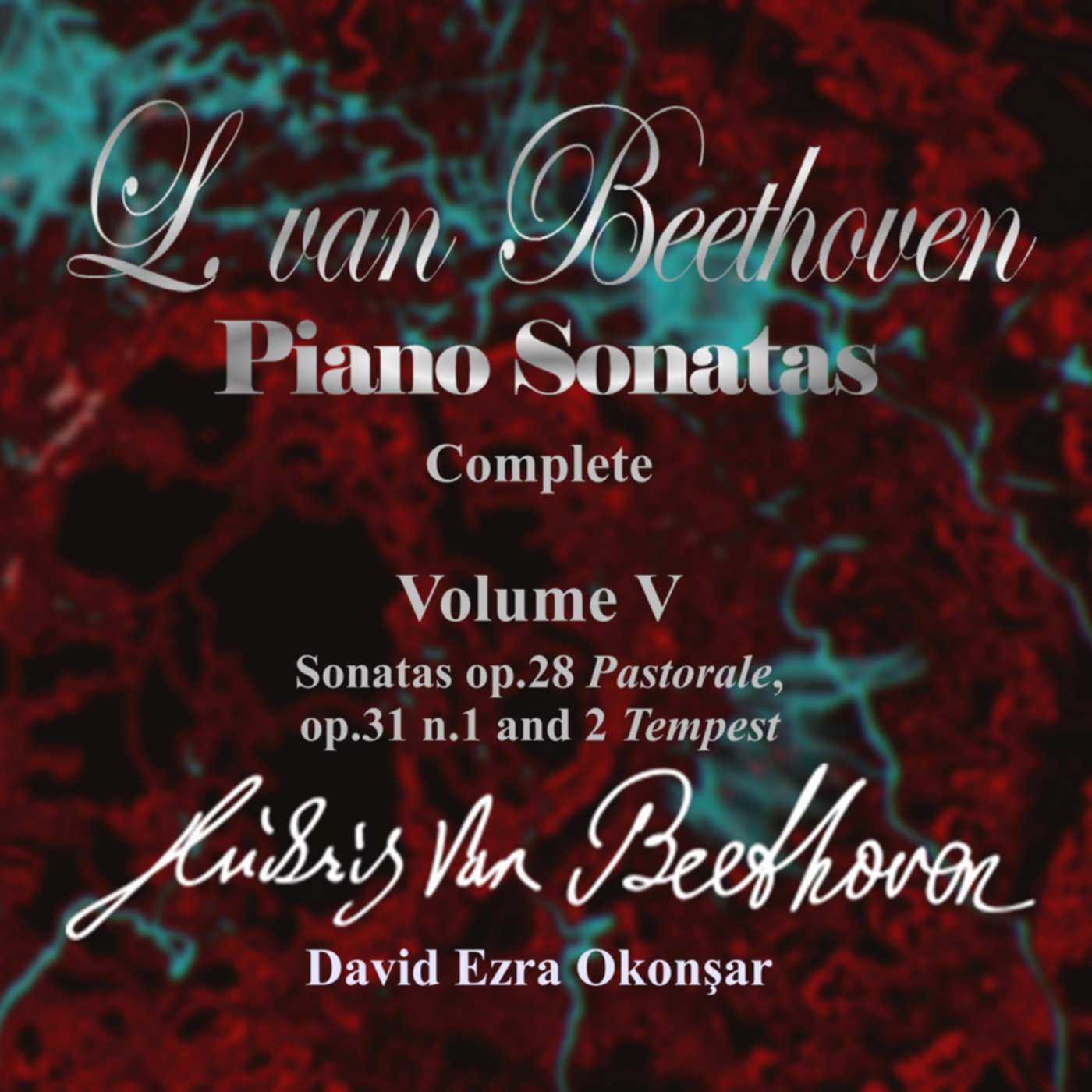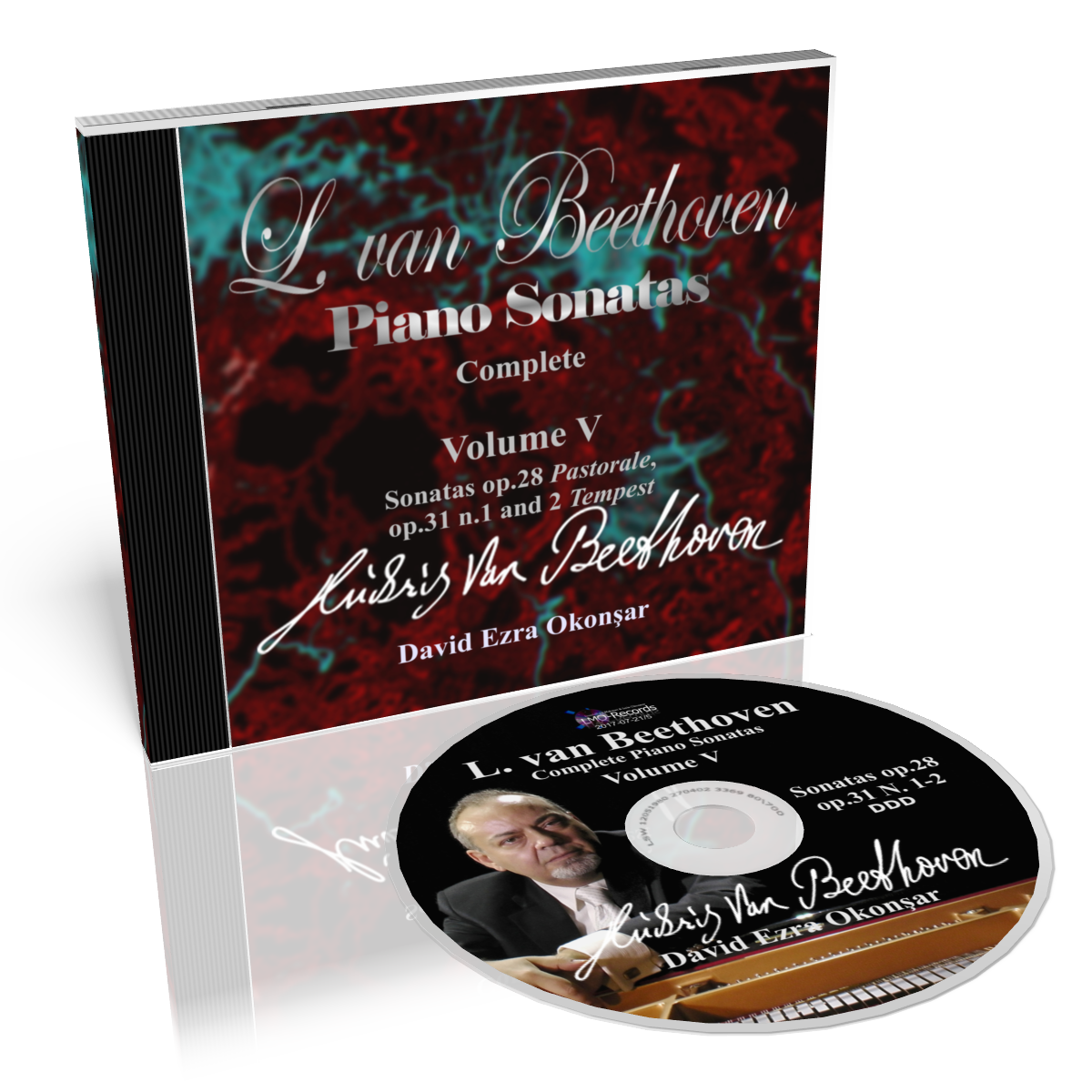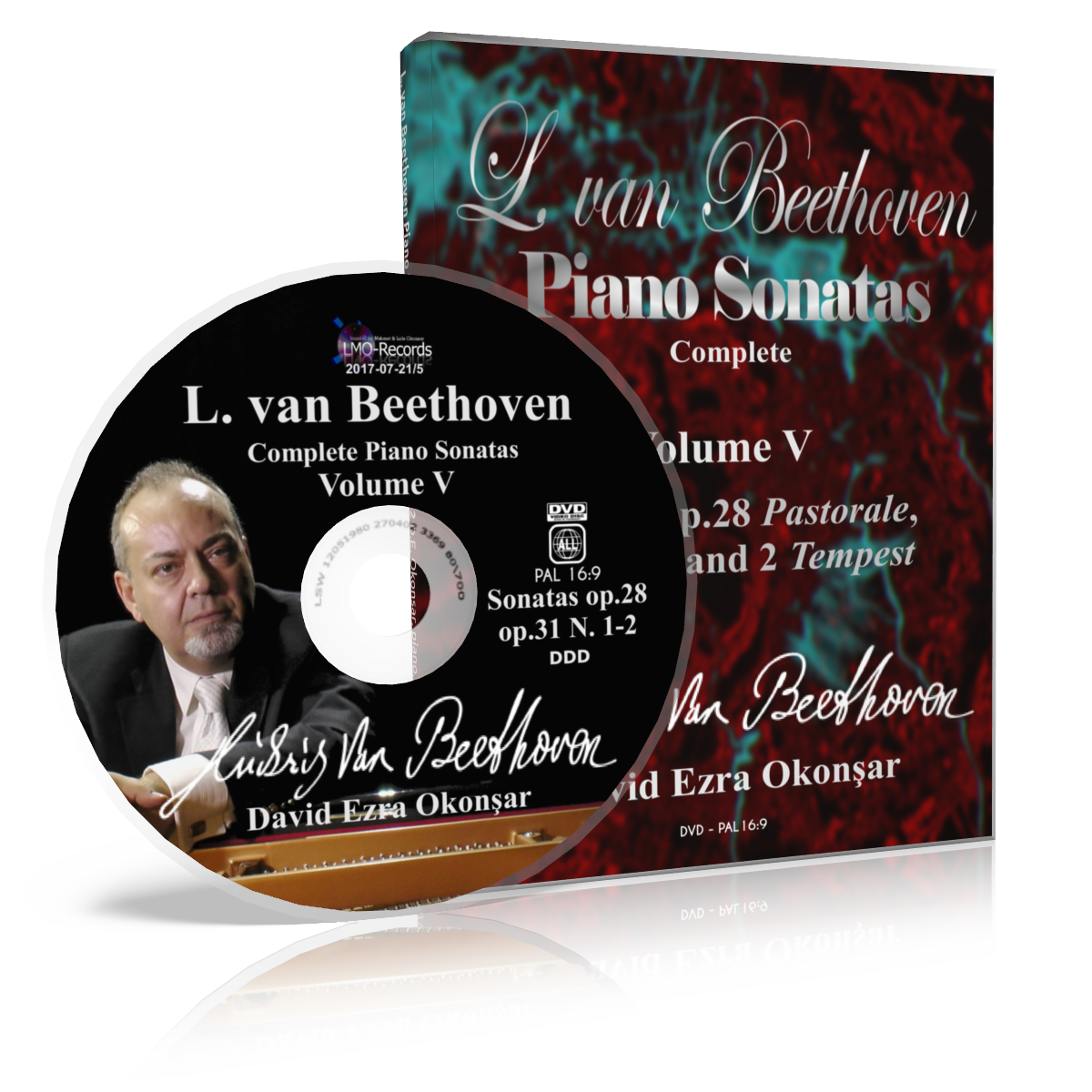
Piano Sonatas
N.15 in D major op.28 "Pastorale"
N.16 in G major op.31 n.1
N.17 in D major op.31 n.2 "Tempest"
Volume 5 of the series:
The Complete Piano Sonatas by Ludwig van Beethoven



|
Volume V of the complete Beethoven Piano Sonatas
series by David Ezra Okonsar featuring Sonatas N. 15 ("Pastorale"), 16
and 17
("Tempest")
Sonata N.15 in D major op.28 "Pastorale"Composed in 1801 and published in 1802 in Vienna as "Opus 28 Grande Sonate pour le pianoforte", its nickname "Pastorale" was given quite late, towards 1838, by the Hamburg based publisher Cranz, the same who named the Sonata opus 57: "Appassionata". Carl Czerny reports that the composer said to his friend Krumpholz: "I am not satisfied with what I composed until now. I will go now to other directions." Yet, still after Czerny, the Andante of the Pastorale Sonata, was one of the composer's favorites, he played it quite often and re-published it in a shortened and fingered version in 1820 as a part of a "Methode pour le pianoforte". Critics at the Allgemeine Musikalische Zeitung wrote on December 8, 1802, that the first and third movements were "original, and even strange, extravagant." The title "Pastorale" is fits perfectly. We know how Beethoven was keen on nature. In a letter to Therese Malfatti he writes: "what a joy for me when I can wander around forests and bushes. Among trees and rocks! No other can love the nature as I do. Woods and rocks only can bring to man the "echo" he is expecting." Young sister work of the sixth symphony, also called "Pastorale", this Sonata started in 1805 shares the same serenity and idyllic joy. I. Allegro The themes are all lyrical, "cantabile". The beginning is very peculiar, with a repeating pedal note D which strangely sounds, at the start at least, not as the tonic of D Major but the root of dominant 7th in the key of G major. The first right hand chord (C-natural - F-sharp - A) comes highly unexpected. It evokes the key of G major before unconvincingly settling in D and it promptly re-starts, still "shifting" towards G major in the repetition of the first theme. That 24 bars-long repeating pedal note D acts sometimes as the tonic root and at other times as root of dominant to G major and creates an enchanting and unique atmosphere. Then one other beautiful theme, the second one, starting at F-sharp minor evolves towards A major. This theme is also set up in a very particular arrangement. It is fully orchestral ecriture. The melody is conveyed with both hands at two octaves distance with the fifth and fourth fingers filled with tremolos in between them, all figuring a strings orchestra setting with first violins and cellos at the cantabile part and second violins and altos "filling in". The development section is made out of a portion of the main theme. With "colorful" modulations in many minor keys. Again the ecriture is fully orchestral with lines on either two violin groups or cellos and basses playing at unison. An evaporating and gracious Coda, again on the "ambiguous" pedal note of D concludes this marvelous depiction of the beauty of the Nature. II. Andante Since the slow movement of the opus 7 Sonata in E-flat major, the arrangement of a "noble" legato chordal, hymn-like melody above a pizzicato-like staccato left hand seems to be one of the favorite settings of the composer. Unlike previous works using this setting only occasionally, here the entire movement is based on it. This ecriture is developed all through the movement with intermediary sections expanding the noble melody to something that may be called "hymn to the grandeur of the Nature". Still a persistent orchestral ecriture everywhere. It is all like if the performer plays a symphony on the piano. III. Scherzo: Allegro vivace Motives of a two-beat structure put in a three beat time signature is again something Beethoven used with great effect most notably in the last movement of the Sonata op.14 N.2. The perception of time and beat is first weakened with successive four dotted double notes, later chords. These single notes or chords do not give the listener a strong feeling about the metric of the piece. When the two-beat-long theme arrives, it disorients the listener even more. The Trio is just the opposite. It is strongly emphases the three beat architecture. So the main idea of this Scherzo seems to be that game between broken down or somewhat intriguing main section as opposed with the strong (Landler-like) three beat impulse melody at the Trio. This Trio also presents an interesting interplay in its tonal setting. It is in B minor and when having moved to D major it shows temporarily a B-flat at the left hand which seems to glimpse towards both D minor and (enharmonically, as a A-sharp) and B minor. IV. Rondo: Allegro ma non troppo The last movement is a kind of very gracious "Bergerie". The lovely rustic landscape evoked by the right hand's two voice theme is again on a pedal note D at the bass. However this time the left hand is more animated and presents almost a two voice setting. A second theme, amazingly close to the one of the last movement of the Pastoral Symphony, is introduced after a series of light arpeggios in both hands which may depict a refreshing breeze. Paul Badura-Skoda beautifully described the fugato-like section evolving by almost chromatic modulations: "like a miniature storm". Sheer joy appears at the brilliant Coda, "quasi Presto" where the left-hand setting of the beginning is now amplified to octaves. Exuberance and exaltation concludes this "really" pastoral, but also fully orchestral Sonata. Sonata N.16 in G major op.31 n.1 This is the first Sonata of three sharing the same opus number: 31. The first two are composed almost simultaneously, it even seems that the number one was composed after the second: op.31 N.2 "Tempest". The first two numbers were published together by Naegeli, published in Zürich in 1803. They will get their dedication only at the time of their third printing by Cappi in Vienna, 1805 when the third one has been added to the series. Eventually they got their opus number (31) when published once more by Simrock at Bonn and Paris. Drafted from October 1801 to May 1802, the Sonata in G major, op.31 N.1, is elaborated at the same time with the second Symphony in D major and one should note that its first theme was previously crafted for a string quartet. It is interesting to note that the Sonata was worked on during the time when Beethoven penned his Heiligenstadt testament, October 6, 1802. Even though the dates in the sketchbooks are somewhat vague, the simultaneity of some tragic events in the life of the composer and the carefree joyfulness of this Sonata is surprising. I. Allegro vivace The disarming beginning with its careless rhythmic displacement of the two hands, a time-shift of one 16th. note, a "limping" effect is unique. The second theme appears in the unexpected key of B minor, it is, by contrast with the first theme, fully and "squarely" set on repeating left hand chords. Development acts on the first theme by presenting it in audacious modulations crossing B-flat major, C minor and D minor. Before the re-exposition a glittering section presents the dominant pedal note of D displaced by a sixteenth note, as the first theme with the left hand crossing over the right with partial dominant chords. The Coda is also full of humor: built on fragments of the initial theme and combining them with short triplet figures together with spasmodic silences. In a pianissimo context, the first theme reappears lastly in fortissimo and the movement ends with pianissimo chords. Everything here is game and humour. II. Adagio Grazioso The second movement is a "Serenade" developed to its "extremes". Guitar-like figures accompany a serenade-divertimento like song. A special kind of serious gravity which is certainly not dramatic, forms the B section of this A - B - A movement. The "A" returns still "almost" happy, with its abundance of trills and leggiero as well as leggierissimo fioritures. By its sheer dimensions and elaboration this movement remains an "enigmatic" serenade, something which looks like a happy love song or a ballade but a shadow of a doubt regarding this apparent happiness persists even after the end. III. Rondo: Allegretto The closing movement is a free construction on the Rondo form. The principal theme has elegantly sinuous melodic elaborations, the other themes are less distinct in their shapes. When the main theme emerges at the left hand as a beautiful cello part, the right hand performs elegant figures in triplets almost as violin parts in this orchestrally elaborated Rondo. The whirling Coda with powerful chords alternating on both hands brings, nevertheless an enigmatic finish in pianissimo for this somewhat cryptic sonata. Sonata N.17 in D major op.31 n.2 "Tempest" It is possible that the D minor Sonata has been drafted before the preceding opus 31.N.1 in G major, probably between the end of 1801 and the first months of 1802. It surely reflects more accurately the state of mind of the composer at those difficult times as the Testament of Heiligenstadt, dated 1802, testifies. According to Carl Czerny, the Allegro of the first movement is inspired by the gallop of a horse heard by Beethoven through his window at the end of the summer 1802. Even though the movement actually reminds the allure of a horse, more of a trotting than a gallop, one should, nevertheless, take those assumptions with extreme care. However, it is known that the composer replied to Schindler who questioned him about the significance of the work "read the Tempest by Shakespeare". He said the same about the Sonata "Appassionata" too. This is certainly not a "programme-music". Following his wish to "go to new directions", to reshape the Sonata form according to the expressibility of the musical discourse, specially the first movement has many audacious innovations. I. Largo-Allegro The 22 bars which make the "introduction" of this movement mark the strong desire of the composer to expand the Sonata form by the strong and succinct establishment of the principle of the dualism which Beethoven regards as the foundation of the Sonata form. First a literally "large" Largo by the expressive arpeggiation of a chord of sixth, ending with a fermata on the dominant tone A. Then a short burst, or "gallop", in Allegro where the elements to be used in the development can be foreseen. Again, the initial impulse is broken at the dominant chord with a fermata. All of that is followed with a new Largo arpeggiation, this time in the unexpected tone of C major (sixth chord). A new and expanded Allegro "gallop" will bring this time the introductory theme, in Allegro and with great power, sustained by frenetic tremolos. All together this powerful opening is already a huge step towards new spheres of expressiveness in the classical Sonata form. The second theme, in A minor, does not temper the urge of the movement in its whole, rather it falls tragically to the lowest ranges of the piano of that time. Expanded arpeggiations start the development, repeated three times, those "enlarged" arpeggiations go through chords of D major 6th., diminished seventh on B-sharp and fourth and sixth on C-sharp. The connections between bass notes: F-sharp to B-Sharp to C-Sharp, as well as the connections between the highest notes: D, F-sharp and A-Sharp are all extraordinarily audacious tonal voice motions. The first theme explodes in F-sharp minor and is repeated, all fortissimo, eight times over a tonal trajectory to bring a climax on a pedal tone A (dominant). The "bridge" section which usually leads to the "re-exposition" constitute here the dramatic climax of the movement. It is astonishing with its novelty in the concept. First it is a long, double, "recitativo" on the same chords of the beginning: sixth chord on C-sharp and sixth chord on E. Another very interesting point, often misunderstood, about those recitatives is the use of the pedal. The authentic text indicates uncut held-down pedaling over each full recitatives. That may sound strange at first because there are many dissonant pitches in each of those sections. Yet, the composer's intention, clearly expressed in the manuscript, is that there should not be any "dry" tones in those very expressive sections. All notes are to be blended and draped in a mysterious gaze. However, It is also true that the instruments (the strings of the "Forte-Pianos") of his time were not resonating as long as our modern-day pianos. So the blend of the tones actually requested by the composer was not as much as it would happen when if the pedal is held down full time on a modern-day piano. According to Andre Boucourechliev, many of those very audacious instrumental and harmonic novelties will also appear later in his ninth Symphony. II. Adagio A large "cantabile" starting, again, with an arpeggiated tonic chord this time. The beginning is a stylized dialogue of two voices between the top and the medium-low ranges and this leads to a long development with a melodious, legato ecriture all over, analogous to low violins and violas playing homophonically a hymn-like chant marked with short tremolo outbursts at the low range, like Timpani, and the highs. Following the re-exposition of the main melody accompanied by fluid arpeggios this time and the hymn-like section transposed, appears a Coda with the elements of the beginning that are now expanded and sliced with tragic silences. III. Allegretto A unique motive made into a kind of "perpetuum mobile" constitutes the last movement. The writing of the left hand part is to be noted for its request to hold the dominant tone of A in its arpeggios. This held tone, A, in both tonic and dominant arpeggios give the melody an obsessional allure. The movement is also noticeable with its long ranging dynamic changes, crescendos and diminuendos, as well brisk changes, forte and piano subitos. It is very interesting to note that the unique fortissimo indication appears just before the Coda, in that sharp jump to the interval of tenth followed by a long chromatic descent without diminuendo. The Sonata ends by a fast running arpeggio to the low D tonic. For more insights into those Sonatas please watch the video "About.." below |
||||||||||||||||||||
|
|
||||||||||||||||||||
|



